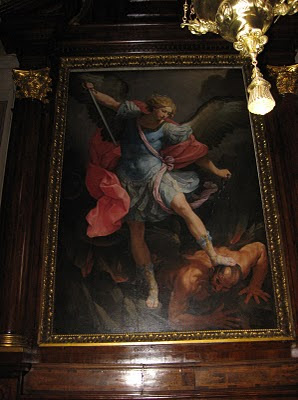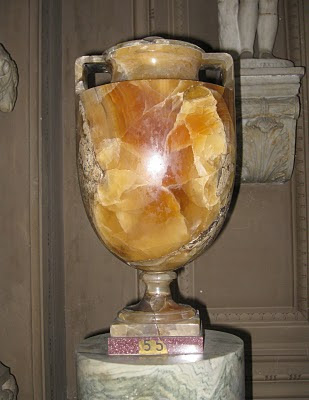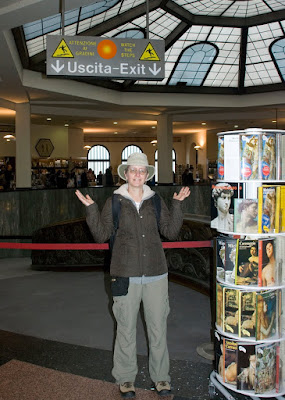
The church of Santa Maria della Vittoria was closest to our hotel but always seemed to be closed when we walked by. So, one morning we made a point of visiting it.
Below is the main altar, which Sean had to photograph, as the light was very dim and my camera just wasn't up to it.
I took a photograph of the ceiling because I found it unique in that although the central oil painting is a typical heaven and hell scenario, it is surrounded by white marble angels that are applied and just hanging by means that are not readily apparent. I felt the effect was spectacular!

Here is a side altar which combines both marble inlays and bas reliefs. Stunning, isn't it? This church was built in the 1600's and I am sure would have swept anyone living at that time into Catholicism.

Another stunning side altar. The oil painting atop it is almost anticlimactic or superfluous. Again, why go to a museum, when the art is in the churches?

This small stained glass window illuminates how every inch of this church is decorated and stylised. Ornate, is it not?

Each altar is hung with it's own censer for burning incense. So I would say there were maybe a dozen or so in this church altogether. All of them are exquisitely beautiful like this one. All churches have them, including St. Peter's. Hmm. Someone should do a book on them!

This church is most notable for the Bernini sculpture of the Ecstasy of St. Teresa as noted in her diary. There was quite a controversy as to whether St. Teresa had experienced a true sexual climax, or just a divine passion when the angel of god visited her and thrust his golden arrow into her repeatedly. The church was not altogether happy with the statue's placement in this basilica. This is Sean's photo, again, as my camera could not get enough light to capture it.

Here is a side altar which combines both marble inlays and bas reliefs. Stunning, isn't it? This church was built in the 1600's and I am sure would have swept anyone living at that time into Catholicism.

Another stunning side altar. The oil painting atop it is almost anticlimactic or superfluous. Again, why go to a museum, when the art is in the churches?

This small stained glass window illuminates how every inch of this church is decorated and stylised. Ornate, is it not?

Each altar is hung with it's own censer for burning incense. So I would say there were maybe a dozen or so in this church altogether. All of them are exquisitely beautiful like this one. All churches have them, including St. Peter's. Hmm. Someone should do a book on them!

This church is most notable for the Bernini sculpture of the Ecstasy of St. Teresa as noted in her diary. There was quite a controversy as to whether St. Teresa had experienced a true sexual climax, or just a divine passion when the angel of god visited her and thrust his golden arrow into her repeatedly. The church was not altogether happy with the statue's placement in this basilica. This is Sean's photo, again, as my camera could not get enough light to capture it.
We continued our wanderings around Rome and found a house we would purchase, were we to move here [right!]:
























































